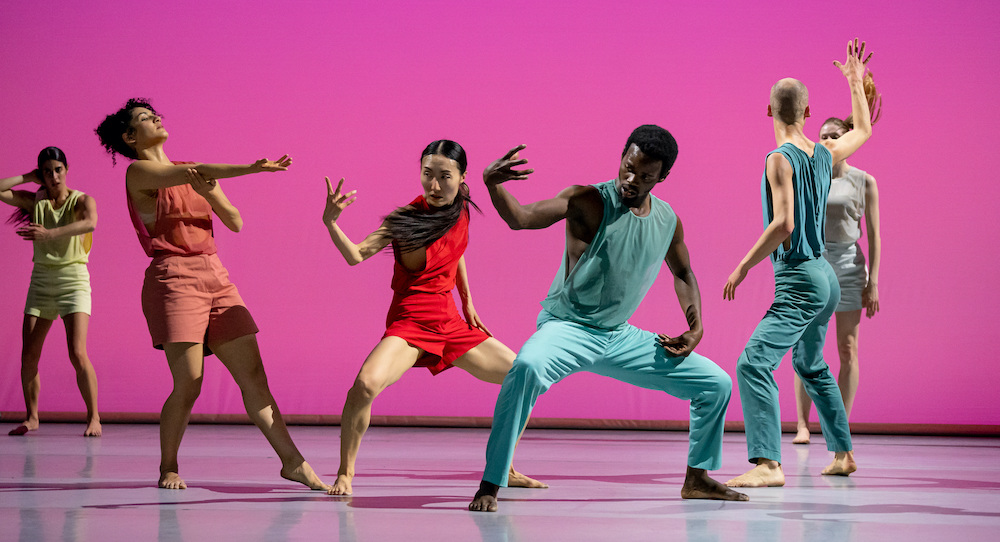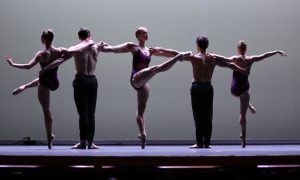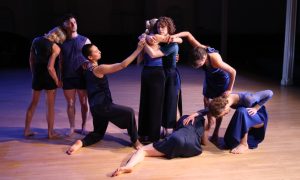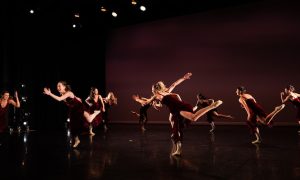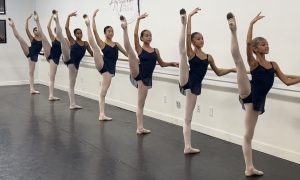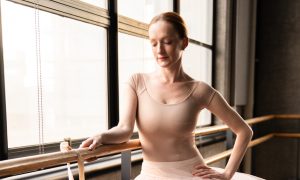Brooklyn Academy of Music, Brooklyn, NY.
April 29, 2022.
Inspired by Terry Riley’s In C, Sasha Waltz & Guests’ dance piece of the same name transcribes Riley’s democratic open score into the bodies of 14 dancers. Alongside the live performance of In C by the musicians of Bang on a Can All-Stars, the dancers improvise their way through 53 choreographic figures to accompany the 53 musical figures of Riley’s piece, and as a result, no two performances are ever the same. According to the program note, the way the score gives freedom to the individual within the ensemble has parallels to the ongoing COVID-19 pandemic: “How can we keep our personal liberty without harming society?”
The piece begins with the dancers silhouetted against a red backdrop, walking and eventually jogging in seemingly random patterns, pausing in clumps here and there. Eventually, one dancer begins moving their shoulder to the music and the others gradually accumulate. Facings shift and phrasework begins to divide the group, a few people leaving at a time as the lights come up and the seemingly colorless costumes turn out to be full of blues, yellows, pinks, and reds. The faces of the dancers are also illuminated; some of them smile effortlessly while others seem unaffected, but there is very little tension or display of effort, and the overall energy is definitively light, conversational and economical.
The movement vocabulary includes lots of straight arms and parallel lines, and constitutes an ongoing flirtation with various technical elements that never quite escalate to outright virtuosity. We are greeted by a multitude of leisurely sautés and casual ball changes. There are hints at chaîné jetés, floating tor jetés with relaxed feet, childlike circular hops with arms outstretched, and frolicking flicks that cut across the space. The movement is highly layered, weaving formations punctuated with poses and tableaux. Very rarely does the group reach full unison, which makes their rare moments of togetherness rewarding. These moments seem to fall apart almost before they arrive, perhaps a comment on the ephemerality of it all –– of dance, of agreement, of democracy and of life itself. At times, some dancers perform movement to the right while others perform it to the left, and at others they mix in with the musicians though the musicians’ position on stage right seems to limit this intermixing unnecessarily.
Little by little, sonic and choreographic possibilities are introduced and we get the sense that this isn’t a piece about beginnings or endings, but about processes. It’s a jog, not a sprint, and we see the sweat slowly pool on the dancers’ foreheads as they look for openings and ways to connect with one another with unwavering focus. At times, In C has the feeling of a recontextualized jam session, with dancers and musicians alike finding their own groove in relation to the group.
The music retains a relatively uniform tone, tempo, and meter throughout, although it does seem to increase in complexity as the piece goes on. The sheer amount of repetition made me think that if I were standing in the back of the theater practicing, I could learn most of the choreography by the time the performance was over. I also wondered how much the dancers’ spatial arrangements were predetermined, and if the same kinds of compositional rules applied to the spacing as to the timing and order of the choreographic figures. One memorable formation is when the dancers form a single file line from front to back, which radiates out triangularly moments after it forms. The ever-shifting configurations and eye-catching choices of individual dancers reminded me of the natural movement patterns that might occur in a city (although one much more colorful and friendly than New York City). Despite the lightness of the movement, the piece maintains a mechanistic quality, acting as a kind of natural engine. (Think more biomimicry than industry.)
For all its pleasing choreographic flourishes, In C could have been half as long and still gotten its message across. The work seems to be saying, “Aren’t formal group dynamics interesting?” And to that I’d answer yes, but not in isolation for an hour straight. I’m all for giving audiences an aesthetic workout when it serves the piece to do so, but there were many moments when In C could have ended that would have been less strenuous on the audience without sacrificing the work’s message. It felt a bit like a fireworks show; a robust series of sparks lights up the sky and you think you’ve just witnessed the finale, but the show continues, defying your expectations of an ending until the sparks have lost their sparkle. Because the piece overstayed its welcome, its wonderfully intricate compositional elements faded into monotony by the time the dancers took their bows.
By Charly Santagado of Dance Informa.


